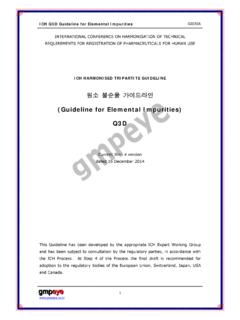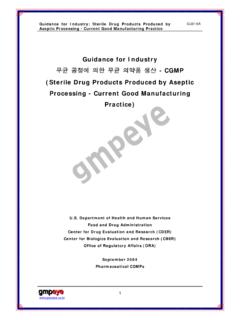Transcription of 안정성 데이터 평가 - gmpeye.co.kr
1 ICH Q1E Evaluation for Stability Data GI007A gggmmmpppeeeyyyeee 1 INTERNATIONAL CONFERENCE ON HARMONISATION OF TECHNICAL REQUIREMENTS FOR REGISTRATION OF PHARMACEUTICALS FOR HUMAN USE ICH HARMONISED TRIPARTITE GUIDELINE (Evaluation for Stability Data) Q1E Current Step 4 version dated 6 February 2003 This Guideline has been developed by the appropriate ICH Expert Working Group and has been subject to consultation by the regulatory parties, in accordance with the ICH Process. At Step 4 of the Process the final draft is recommended for adoption to the regulatory bodies of the European Union, Japan and USA. ICH Q1E Evaluation for Stability Data GI007A gggmmmpppeeeyyyeee 2 Q1E Document History First Codification History Date New CodificationNovember 2005 Q1E Approval by the Steering Committee under Step 2 and release for public consultation6 February 2002 Q1E Current Step 4 version Q1E Approval by the Steering Committee under Step 4 and recommendation for adoption to the three ICH regulatory bodies.
2 6 February 2003 Q1E ICH Q1E Evaluation for Stability Data GI007A gggmmmpppeeeyyyeee 3 EVALUATION FOR STABILITY DATA ICH Harmonised Tripartite Guideline Having reached Step 4 of the ICH Process at the ICH Steering Committee meeting on 6 February 2003, this guideline is recommended for adoption to the three regulatory parties to ICH. 1. ( introduction ) (Objectives of the Guideline) (Background) (Scope of the Guideline) 2. (GUIDELINES) (General Principles) (Data presentation) (Extrapolation) (Data Evaluation for Retest Period or Shelf Life Estimation for Drug Substances or Products Intended for Room Temperature Storage) (No significant change at accelerated condition) (Significant change at accelerated condition) (Data Evaluation for Retest Period or Shelf Life Estimation for Drug Substances or Products Intended for Storage Below Room Temperature) (Drug substances or products intended for storage in a refrigerator) (Drug substances or products intended for storage in a freezer)
3 -20 C (Drug substances or products intended for storage below -20 C) ICH Q1E Evaluation for Stability Data GI007A gggmmmpppeeeyyyeee 4 (General Statistical Approaches) 3. (APPENDICES) Appendix A: ( ) (Decision Tree for Data Evaluation for Retest Period or Shelf Life Estimation for Drug Substances or Products (excluding Frozen Products)) Appendix B: (Examples of Statistical Approaches to Stability Data Analysis) ICH Q1E Evaluation for Stability Data GI007A gggmmmpppeeeyyyeee 5 EVALUATION FOR STABILITY DATA 1. ( introduction ) (Objectives of the Guideline) This guideline is intended to provide recommendations on how to use stability data generated in accordance with the principles detailed in the ICH guideline Q1A(R) Stability Testing of New Drug Substances and Products (hereafter referred to as the parent guideline) to propose a retest period or shelf life in a registration application.
4 This guideline describes when and how extrapolation can be considered when proposing a retest period for a drug substance or a shelf life for a drug product that extends beyond the period covered by available data from the stability study under the long-term storage condition (hereafter referred to as long-term data). ICH "Q1A(R) "( " ") . " "( " ") , , . (Background) The guidance on the evaluation and statistical analysis of stability data provided in the parent guideline is brief in nature and limited in scope. The parent guideline states that regression analysis is an appropriate approach to analyzing quantitative stability data for retest period or shelf life estimation and recommends that a statistical test for batch poolability be performed using a level of significance of However, the parent guideline includes few details and does not cover situations where multiple factors are involved in a full- or reduced-design study.
5 , . , ICH Q1E Evaluation for Stability Data GI007A gggmmmpppeeeyyyeee 6 . This guideline is an expansion of the guidance presented in the Evaluation sections of the parent guideline.. (Scope of the Guideline) This guideline addresses the evaluation of stability data that should be submitted in registration applications for new molecular entities and associated drug products. The guideline provides recommendations on establishing retest periods and shelf lives for drug substances and drug products intended for storage at or below room temperature *. It covers stability studies using single- or multi-factor designs and full or reduced designs. NME(new molecular entity).
6 " " .. * Note: The term room temperature refers to the general customary environment and should not be inferred to be the storage statement for labeling. : " " . ICH Q6A and Q6B should be consulted for recommendations on the setting and justification of acceptance criteria, and ICH Q1D should be referenced for recommendations on the use of full- versus reduced-design studies. ICH Q6A Q6B , ICH Q1D . 2. (GUIDELINES) (General Principles) The design and execution of formal stability studies should follow the principles outlined in the parent guideline. The purpose of a stability study is to establish, ICH Q1E Evaluation for Stability Data GI007A gggmmmpppeeeyyyeee 7 based on testing a minimum of three batches of the drug substance or product, a retest period or shelf life and label storage instructions applicable to all future batches manufactured and packaged under similar circumstances.
7 The degree of variability of individual batches affects the confidence that a future production batch will remain within acceptance criteria throughout its retest period or shelf life.. 3 , / .. Although normal manufacturing and analytical variations are to be expected, it is important that the drug product be formulated with the intent to provide 100 percent of the labeled amount of the drug substance at the time of batch release. If the assay values of the batches used to support the registration application are higher than 100 percent of label claim at the time of batch release, after taking into account manufacturing and analytical variations, the shelf life proposed in the application can be overestimated. On the other hand, if the assay value of a batch is lower than 100 percent of label claim at the time of batch release, it might fall below the lower acceptance criterion before the end of the proposed shelf life.
8 / , 100% . 100% , / . 100% , . A systematic approach should be adopted in the presentation and evaluation of the stability information. The stability information should include, as appropriate, results from the physical, chemical, biological, and microbiological tests, including those related to particular attributes of the dosage form (for example, dissolution rate for solid oral dosage forms). The adequacy of the mass balance should be assessed. Factors that can cause an apparent lack of mass balance should be considered, including, for example, the mechanisms of degradation and the stability-indicating capability and inherent variability of the analytical procedures.
9 ( , ICH Q1E Evaluation for Stability Data GI007A gggmmmpppeeeyyyeee 8 ) , , , .. ( ) . The basic concepts of stability data evaluation are the same for single- versus multifactor studies and for full- versus reduced-design studies. Data from formal stability studies and, as appropriate, supporting data should be evaluated to determine the critical quality attributes likely to influence the quality and performance of the drug substance or product. Each attribute should be assessed separately, and an overall assessment should be made of the findings for the purpose of proposing a retest period or shelf life. The retest period or shelf life proposed should not exceed that predicted for any single attribute.
10 / / . , . , .. The decision tree in Appendix A outlines a stepwise approach to stability data evaluation and when and how much extrapolation can be considered for a proposed retest period or shelf life. Appendix B provides (1) information on how to analyze long-term data for appropriate quantitative test attributes from a study with a multifactor, full or reduced design, (2) information on how to use regression analysis for retest period or shelf life estimation, and (3) examples of statistical procedures to determine poolability of data from different batches or other factors. Additional guidance can be found in the references listed; however, the examples and references do not cover all applicable statistical approaches.














